Corn phytochemicals and their health benefits
Siyuan Sheng,Tong Li,RuiHai Liu
Department of Food Science,Cornell University,Ithaca,NY,14850-7201,United States
ABSTRACT Whole grain has a wide range of phytochemicals exhibiting health benefits of lowering risk of chronic diseases.As commonly consumed grain product,corn has unique profiles of nutrients and phytochemicals when compared with other whole grains.Corn nutrients and phytochemicals include vitamins(A,B,E,and K),minerals(Mg,P,and K),phenolic acids(ferulic acid,coumaric acid,and syringic acid),carotenoids and flavonoids (anthocyanins),and dietary fiber.More and more scientific evidences have shown that regular consumption of whole grain corn lowers the risk of developing chronic diseases such as cardiovascular disease,type 2 diabetes,and obesity and improves digestive health.Further studies on bioactive compounds of corn related to health are needed.
Keywords:Corn Maize Whole grains Phytochemicals Cardiovascular disease Resistant starch Type II diabetes Diet and chronic diseases
1.Introduction
Corn,known as maize (Zea maysL.),is originated in America.It was discovered by an European explorer,Christopher Columbus,in 1492,and later,was introduced to Europe,China,and all over the world within the following 100 years [1,2].Corn is one of the major food sources in the world.Corn contains significant amounts of bioactive compounds providing desirable health benefits beyond its role as a major source of food.Beside corn grain,sweet corn is considered as one of the most popular vegetables in North America and China,and its popularity has rapidly increased in the world.Sweet corn is among the top six vegetables consumed in the United States [3].Canned and frozen sweet corn is ranked the third in among vegetables consumed in the United States,only behind the canned tomatoes and frozen potatoes[4].
Previously,phytochemicals of corn have received less attention than these of fruits and vegetables.The consumption of corn and other whole grain products has been linked to the reduced risk of chronic diseases including cardiovascular disease [5–8],type 2 diabetes [9–12],obesity [13,14],some cancers [15–22],and with the improvement of digestive tract health[23–25].
Health promoting effects of phytochemicals of fruit and vegetables including antioxidant activities and antiproliferative activities have been well reported [26–28].However,the health benefits of the whole grains have long been underestimated [30].Whole grains are composed of intact,ground,cracked or flaked caryopsis,in which the principle components,the starchy endosperm,germ,and bran are presented in the same relative proportions as existed in the intact caryopsis[29].The health benefitsof corn are not only from basic nutrients such as carbohydrates,vitamins and minerals,but also from their unique phytochemicals such as phenolic acids.The major components of corn kernel include endosperm,germ and bran,and each of them contains a different phytochemical profiles.Along with the health promoting compounds such as amylase in corn endosperm,a wide range of phytochemicals such as total phenolics and phenolic acids(vannilic acid,syringic acid,courmaric acid,ferulic acid and caffeic acid)are found in corn bran and germ fractions at high concentrations.Adom&Liu et el.discovered that the majority phytochemicals in corn with beneficial effects on human health are presented in the bran and germ fractions and not the endosperm,with about 87%of total phenolic content(TPC)presented in the bran and germ fractions.Thus,corn flour with ground germ,endosperm and bran contains higher bioactive compounds than refined cornstarch and refined corn oil[1,30].
All corn types are rich in dietary fiber,vitamins(A,B,E,and K),minerals(magnesium,potassium and phosphorus),phenolic acids and flavonoids,plant sterols,and other phytochemicals (lignins and bound phytochemicals).However,different varieties of corn contain significantly different phytochemical profiles in terms of flavonoids and carotenoids.Blue,red,and purple corn possess higher concentration of anthocyanidins (up to 325 mg/100 g DW corn) including cyanidin derivatives (75%–90%),peonidin derivatives (15%–20%) and pelargonidin derivatives (5%–10%).Yellow corn is rich in carotenoids(up to 823 μg/100 g DW corn)including lutein (50%),zeaxanthin (40%),β-cryptoxanthin (3%),β-carotene(4%),and α-carotene(2%).High amylose corn is rich in amylose(up to 70%of all carbohydrates)[31–35].Therefore,the consumption of combined different corn varieties provides wide range of phytochemicals with optimum nutritional benefits from corn.The additive and synergistic effects of bioactive compounds in corn and other whole grains along with many other nutrients and phytochemicals in fruits and vegetables may be responsible for their health benefits in reduced risk of chronic diseases [36].Starting in 1995,a daily recommendation of 6–11 sevings of grain products was recommended;in the 2005 nutrition guidelines,consumption of whole grains was first mentioned;and in the most recently 2015 dietary guideline for Americans recommends,it is recommended to consume more than 170 g of grains daily,and half of them should be in whole grain form.However,the average intake of whole grains in the United States is less than one serving per day,and 90%of Americans do not meet the recommendations for whole grain consumtion[13,37].
The purpose of this review will focus on the recent research of the major nutrients and phytochemicals of corn and their potential health benefits related to the dietary prevention of chronic diseases.
2.Macro-and micro-nutrients in corn
Every 100 g of corn provides 365 calories and every100 g of sweet corn provides 86 calories.Carbohydrates and water are the main chemical substances in corn.Carbohydrates content in corn close to 75% in and carbohydrates content in sweet corn takes account nearly 18%.Water content in corn is about 10%and water content in sweet corn is about 75%.Corn and sweet corn provide a wide variety of vitamins(carotenoids,thiamine,riboflavin,niacin,pyridoxine,folate,ascorbic acid,vitamin E and vitamin K),minerals(calcium,magnesium,phosphorus,potassium,sodium and zinc)and resistant starches.The nutrition profiles of corn and sweet corn are similar,with the only exception being vitamin C,which is only found in sweet corn.Lipids in corn and sweet corn are mostly presented in mono- (30%) and poly- unsaturated (50%) forms with a small portion of lipids in the saturated form(20%).
3.Corn phytochemicals
“Phyto”in the word of phytochemicals is derived from the Greek word “phyto”,which means plant.Phytochemicals are the bioactive non-nutrient chemical compounds found in plants such as fruits,vegetables and whole grains,which may function in reducing the risk of chronic diseases [36].Although it is estimated at least more than 5000 dietary phytochemicals have been discovered,it is believed that a high percentage of phytochemicals in foods still remain unknown [36].Like many other grain products,phytochemicals in corn are also distributed mainly in the kernel and bran [30,38].Phytochemicals composition varies among different type of corn.Carotenoids are concentrated in yellow and red corn,anthocyanins are concentrated in red,blue,purple and black corn,and phytosterols are concentrated in kernel part of corn[39].
Corn has the highest total antioxidant activity(181.4±0.86 μmol of vitamin C equiv/g of grain) among all common grains such as rice,wheat and oats[30].Phytochemicals are the major contributors to the total antioxidant activity in corn.Flavonoids and ferulic acids contribute to the total phenolics in corn and are directly related to the total antioxidant activity,87%of them were in bound form [30].Thermal processing increases the antioxidant activity of sweet corn by releasing bound form phytochemicals [40].Dewanto et al.firstly reported that thermal processed sweet corn had higher antioxidant activity than the unprocessed sweet corn[40].
3.1.Phenolics
Phenolics are defined as chemical substances possessing one or more aromatic rings with one or more hydroxyl groups in their structures[41].They are commonly categorized as phenolic acids,flavonoids,stilbenes,coumarins,and tannins [41].Among these phenolics,flavonoids and phenolic acids are the major compounds found in corn.Total phenolic content varies among different corn varieties,and the range is from 243.8±4.6 to 320.1±7.6 mg of gallic acid equiv/100 g of dry weight (DW) of corn.High carotenoid corn (320.1±7.6 mg of gallic acid equiv/100 g of DW of grain)has the highest total phenolic content followed by yellow corn(285.8±14.0 mg of gallic acid equiv/100 g of DW of corn),blue corn(266.2±0.7 mg of gallic acid equiv/100 g of DW of grain),white corn (260.7±6.1 mg of gallic acid equiv/100 g of DW of grain),and red corn (243.8±4.6 mg of gallic acid equiv/100 g of DW of grain)[33].Adom and Liu reported that corn had the highest total phenolic content (15.55±0.60 μmol/g of grain) among all commonly consumed grains such as rice(7.99±0.39 μmol/g of grain),oats(6.53±0.19 μmol/g of grain)and wheat(5.56±0.17 μmol/g of grain)[30](Fig.1).
3.1.1.Phenolics acids
Phenolic acids are one of the major phytochemical components of corn.Phenolic acids can be subdivided into hydroxybenzoic acid and hydroxycinnamic acid derivatives (Fig.2) [36].In corn,phenolic acids contribute to the sour,bitter,and astringent taste,at taste level threshold of 40–90 ppm [42].Natural phenolic acids such astrans-cinnamic acid and ferulic acid are considered as effective fungitoxicants forA.flavusandA.parasiticusin corn [43].For hydroxybenzoic acids,vannilic acid and syringic acid are detected in corn,and for hyrocinnamic acid,p-courmaric,ferulic and caffeic acids are detected in corn.[44].The structures of benzoic acids and cinnamic acids are displayed in Fig.2(Table1).
Sosulski et al.reported that total phenolic acid content in yellow dent corn flour was 309 ppm,andcisandtrans-ferulic,p-courmaric and syringic acids were the predominant phenolic acids in corn flour.The distribution of free and soluble and bound form of different phenolic acids in corn flour is shown in Table2 [45].The phenolic acid found in the highest quantities in corn is ferulic acid and is mainly presented in the bound form linked to cell wall structural components such as celluloses,lignins and proteins by ester bonds [15].Different from the results reported by Sosulski et al.,Adom & Liu reported that more ferulic acids presented predominately in bound form while the former research(Table2) indicated lower contrast ratio of different form of ferulic acids.total ferulic acid content in corn is 906.13±9.09 μmol/100 g of grain,98.9%of that is in bound form,1%is in soluble conjugate form and only 0.1%is in free from[30].From the data above,the bound,soluble conjugate and free form ratio for ferulic acid is 100:1:0.1.Thus processing techniques such as thermal processing,pasteurization,fermentation,and freezing play critical roles in releasing bound phenolic acids and increasing their total antioxidant activity by 44%to reach the optimum nutrition value of corn[30,40].

Fig.1.Structures of common phenolic compounds.
3.1.2.Flavonoids
Flavonoids are the largest group of phenolic compounds in corn.It has been reported by epidemiological studies that high consumption of flavonoids reduce the risk of chronic diseases including CVD,diabetics,and cancers [36].The generic structure of flavonoids consists of 2 aromatic rings (A and B rings) linked by an oxygenated heterocycle ring,known as C ring.Different structures in the C ring of flavonoids classify them into flavonols,flavones,flavanols,flavanones,anthocyanins,and isoflavonoids[41].Flavonoids content various among corn varieties,as a most consumed corn variety,total flavonoid content in yellow corn is about 1.68±0.17 μmol catechin equiv/g.Most of them are in bound form (1.52±0.03 μmol catechin equiv/g),with a small amount in the free form(0.16±0.004 μmol catechin equiv/g)[30].
Anthocyanins are one of major groups of water soluble flavonoids in corn,imparting the color of purple to pinkish depending on the pH levels and concentrations.Pericarp in corn contains the highest level of anthocyanins (up to 50%),and aleurone contains a small portion of anthocyanin [46].The color of the corn kernel indicates the content of anthocyanins.Purplish-red corn kernel contains the highest amount of anthocyanins (141.7 mg anthocyanins/100 g flour),and blue corn kernel contains less anthocyanins(62.7 mg/100 g flour)[35].Six major and 17 minor anthocyanins have been identified from purple corn.The structures of major anthocyanins found in purple corn are shown in Fig.3 including perlargonidin-3-glucoside,cyanidin-3-glucoside,delphinidin-3-glucoside,peonidin-3-glucoside,petunidin-3-glucoside,and malvidin-3-rutinoside[47,48].
Anthocyanins in colored corn may have a positive effect on digestive health.A twelve-week animal study conducted by Wu et al.suggested that anthocyanins reduced the risk of colon cancer by increasing fecal butyric acid content as well as lowering the body weight by 16.6%at 200 mg kg treatment[49].Some other research supported the same results [50,51]and the proposed mechanism is that corn anthocyanins inhibit the synthesis of fatty acids and triacylglycerol by suppressing the mRNAs level of enzymes thus decreasing the accumulation of triacylglycerol in liver and white adipose tissue.Among the anthocyanins in purple corn,cyanidin 3-O-β-D-glucoside possess substantial health benefits such as antiinflammatory beyond its antioxidant effect[52].
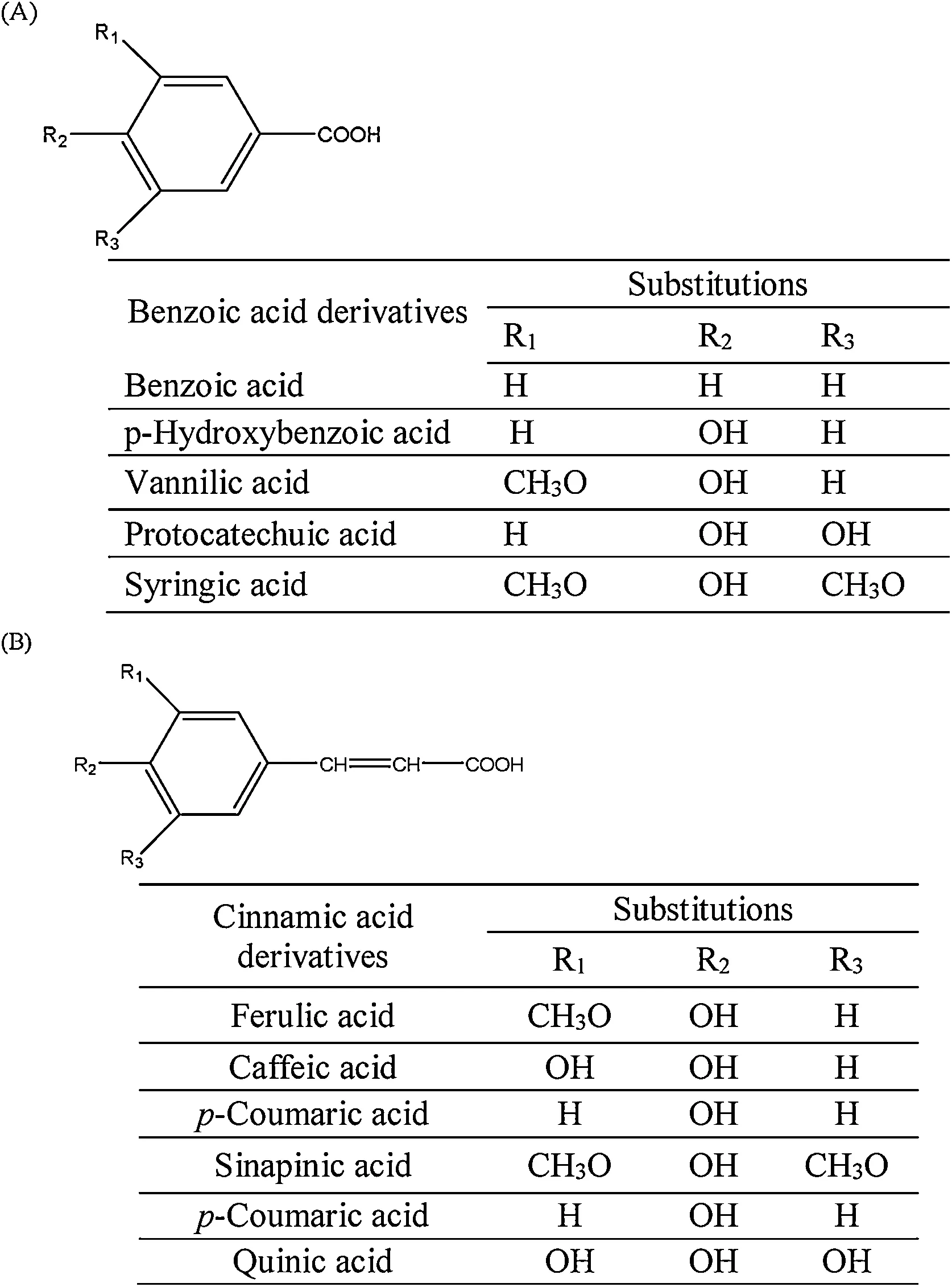
Fig.2.Structures of common phenolic acids found in corn:(A)benzoic acid derivatives and(B)cinnamic acid derivatives(Adopted from Liu,2007).
3.2.Carotenoids
Carotenoids are natural pigments with yellow,orange,and red colors.More than 600 carotenoids have been identified in nature.Their physiological functions in promoting health are as pro-vitamin A and as antioxidants quenching singlet oxygen radicals.Carotenoids generally have a 40-carbon skeleton of isoprene unites cyclized at one or both ends[15].The majority of carotenoids that occur in nature are intransform.Because of the long series of conjugated double bonds in the central part of its chemical structure,carotenoids exhibit light absorbing and unique singlet oxygen quenching capability [53].Carotenoids are lipid-soluble compounds,thus the absorption of carotenoids requires 3–5 grams of fat/oils presented in a meal.Processing such as mechanical homogenization and thermal processing may increase carotenoid bioavailability.On the other hand,un-absorbable fat-soluble com-pounds may reduce carotenoid bioavailability by one order of magnitude[54–56].
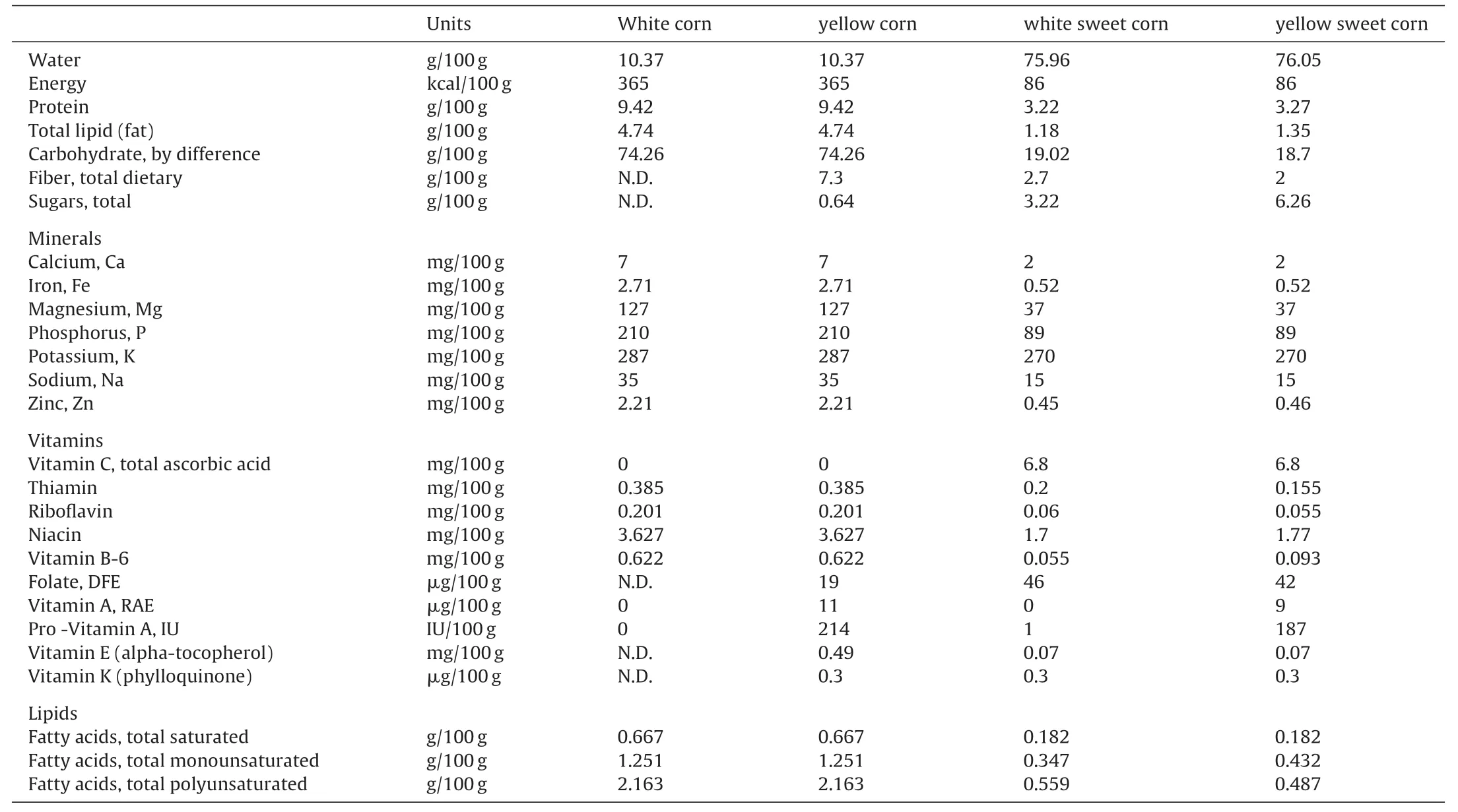
Table1 Nutrient profiles of corn and sweet corn(data reported on wet basis)a.
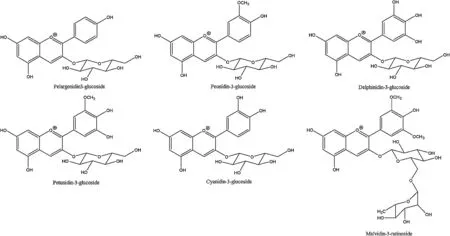
Fig.3.Structure of common anthocyanins found in purple corn[48].
3.2.1.Carotenes
β-carotene,α-carotene and β-cryptoxanthin are pro-vitamin A carotenoids,which means they can be converted to retinol (Vitamin A) in the human body,whereas xanthophylls do not possess this function.Theoretically,one molecule of β-carotene can be converted into two molecules of retinol through enzymatic reactions mainly in the intestinal mucosa.Realistically,the conversion rate of pro-vitamin A to retinol is lower,vitamin A conversion rates of βand α-carotenoids are expressed in retinol equivalents(RE)basedonin vivotests where 1 RE=1 μg of retinol=6 μg of β-carotene or 12 μg of α-carotene[57].The conversion of pro-vitamin A to retinol is up to the individual status of vitamin A,and regulation mechanisms inhibit the conversion to vitamin A if retinol content in the human body is over the demand of body[58,59].
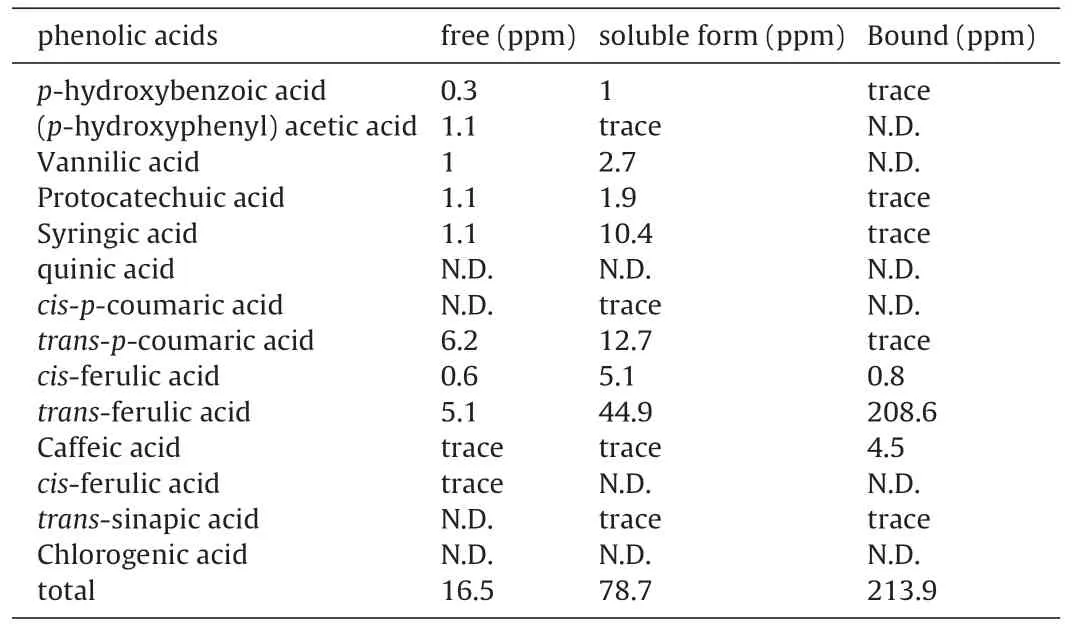
Table2 Free,soluble and bound forms of different phenolic acids in yellow dent corn flour(data reported on dry weight basis)[45].
3.2.2.Xanthophylls
Unlike other carotenoids,xanthophylls(lutein and zeaxanthin)cannot be converted into vitamin A.Lutein and zeaxanthin are selectively taken up into the macula region (yellow spot) in eye,where they absord 90% of blue light (450–470 nm) thus reducing the shortwave length light from reaching the critical part of eye and causing oxidative damage and stress[15,60].The average xanthophyll concentration in corn(the sum of lutein,zeaxanthin and β-cryptoxanthin)is 21.97 ug/g corn.Lutein is 15.54 μg/g corn,zeaxanthin is 5.84 μg/g corn,and β-cryptoxanthin is 0.54 μg/g corn[61].De la Parra et al.measured carotenoid content of white,yellow,red,blue and high carotenoid corn,and data is shown in Table3 [33].The chemical structures of major carotenoids identified in corn are shown in Fig.4.
3.3.Vitamin E
Vitamin E is a family of eight isomers (vitamers) with two types of structures,the tocopherols (α-tocopherol,β-tocopherol,γ-tocopherol,δ-tocopherol) and the tocotrienols (α-tocotrienol,β-tocotrienol,γ-tocotrienol,and δ-tocopherol) [15].The generic structures of the 2 classes of Vitamin E are composed of a 6-hydroxychroman group and a phytol side chain made of isoprenoid unites(Fig.5),with tocopherols and tocotrienols sharing a similar chemical structure with minor differences on the phytol side chain.Tocopherols have saturated phytol side chains while tocotrienols have carbon-carbon double bonds in the phytol side chain[15].The main functions of vitamin E in human body are maintaining membrane integrity and as lipid soluble antioxidant.When compared with tocopherols,tocotrienols have stronger function in preventing cancer and cardiovascular diseases [62–65].Vitamin E also improves immune system function and repairs DNA damage[66].All vitamin E vitamers are found in corn,with the only exception of β-tocotrienol.Total vitamin E content is 66.9 mg/kg DW of yellow corn,including 3.7 mg/kg DW corn of α-tocopherol,5.3 mg/kg DW corn of α-tocotrienol,0.2 mg/kg DW corn of β-tocopherol,45 mg/kg DW corn of γ-tocopherol (the major isomer in corn),11.3 mg/kg DW corn of γ-tocotrienol,1.0 mg/g DW corn of δ-tocopherol,and 0.4 mg/kg DW corn of δ-tocotrienol [67].About 95% of vitamin E isomers are found in the germ faction of corn[68](Fig.6).

Table3 Major phenolic acids content in yellow,Mexican blue,American blue and white corn[45,108].
3.4.Phytosterols
Phytosterols are a collective term for plant sterols and stanols with a similar structure as cholesterol,differing only in the side chains [15].They are the essential components of plant cell walls and membranes.As minor constituents in corn oil,phytosterols are classified into sub-groups:4-demethylsterols,simply sterols,4,4-dimethylsterols,4-monomethylsterols,and sitosterols.The classification is based on the number of methyl group at the C-4 position[69,70].
It s much easier for me to explain things by talking than it is to write. I m really good at dictating4, but my teachers don t always let me. If I am asked to write an essay on my trip to Washington and Philadelphia, it s like a punishment. But if I can dictate5 it, or just get up and talk about it, I can tell everyone about the awesomeness6 of seeing the Declaration of Independence in the National Archives or the feeling of true patriotism7 that rushed through me when I stood in the room where our founding fathers debated the issues of freedom.
Corn oil is rich in phytosterols,56 to 60% of phytosterols in corn oil occur as steryl esters,while esterified sterol content is much lower in other vegetable oils [71].The majority of vegetable oils contain 1–5 g/kg of plant sterols,while corn oil contains 5.13 to 9.79 g/kg of plant sterols [72].Crude corn oil contains a higher plant sterol content (8.09–15.57 g/kg) than the refined oil(7.15–9.52 g/kg)[72,73].In the corn kernel,the germ fraction contained the highest amount of oil (24.2%–30.7%),while endosperm and pericarp factions only contained 0.4%–1.2% oil.Sitosterol is the predominant phytosterols found in corn,which accounts for approximately 77%–87% of all phytosterols extracted from corn,followed by campestanol,which accounts for 13%–23%.Stigmasterol and delta5-avenasterolare were found in trace amount in corn.The endosperm fraction contained the highest level of phytostanols.[74].High intakes of plant sterols(1.6 g per day)can lower serum LDL and total cholesterol concentrations without affecting HDL cholesterol concentration in humans[75].The proposed mechanism is that phytosterols and cholesterol compete for the micelle formation in the intestine,thus inhibiting the absorption of cholesterol[76].
3.5.Other bioactive compounds
Besides the major bioactive compounds listed above,there are some other bioactive compounds found in corn [77].Four types of resistant starches have been identified based on their structures,natures and sources [78,79].Type 2 resistant starch (RS2),a starch difficult to digest due to its native granules structure,is the major resistant starch found in corn and presented at a high level in high amylose corn.High amylose corn (70% amylose) has the highest amylose content among all whole grains [80].Due to the nature of starch granules,RS2 is resistant to digestion in intestine exhibiting beneficial effect on blood sugar and colon health[81].Lignins (lariciresinol,matairesinol,pinoresinol,and secoisolariciresinol)is a common bioactive compounds found in all whole grains,with health benefits such as anticancer and antioxidant effect[82].Secoisolariciresinol is present in corn at 12 μg/100 g DW and lariciresinol is present at 11 μg/100 g DW,while matairesinol and pinoresinol are not presented in corn[83].
4.Health benefits
Whole grain corn is rich in nutrients and bioactive compounds including fiber,vitamins,minerals,and phytochemicals.More and more scientific evidence suggests the regular consumption of whole grains reduce the risk of developing chronic diseases,including CVD,type-II diabetics,overweight and obesity,and digestive disorders(Tables 4 and 5).
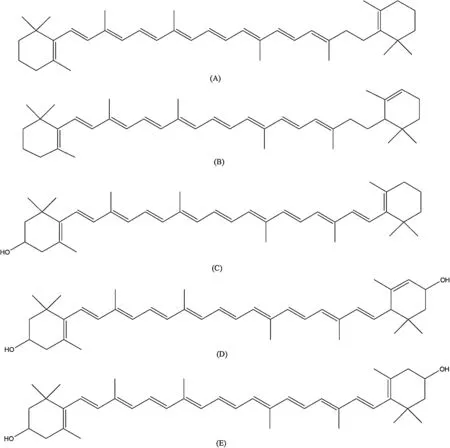
Fig.4.Structures of carotenoids found in corn:β-carotene(A),α-carotene(B),β-cryptoxanthin(C),Lutein(D),and Zeaxanthin(E)(Adopted from Liu,2007).
4.1.Cardiovascular disease(CVD)
It has been reported by the World Health Organization that 17.7 million people died from CVDs in 2015,and by 2030,23 million people will die of CVD annually around the world[84].Many recent epidemiological studies and clinic interventional trials suggest a strong association of the increased consumption of whole grains and whole grain-derived products with the reduced risk of CVD[5–7,85,86].
Tighe et al.reported that whole grain consumption and CVD on middle aged people and suggested that 3 portions of daily consumption of whole grain foods lowered the risk of CVD by lowering blood pressure in a randomized controlled trial (RCT).All 233 participants were separated into three groups treated with refined,wheat,and oat plus wheat diets.After 16 weeks,significant decreases of both systolic and diastolic blood pressure in the oat plus wheat group was observed.The researchers suggested that the blood pressure lowering effect was contributed by the high amount of viscous soluble fiber(β-glucans)in whole grains[7].Holloender et al.conducted a meta-analysis of randomized controlled trials(RCT)and concluded whole grains,including corn,rye,and brown rice,lowered risk of CVD(20%–25%reduction)when compared with the refined grains.The mechanism is due to lowering LDL cholesterol and total cholesterol without effects on HDL cholesterol or triglycerides[85].
Mellen et al.reported a meta-analysis on seven prospective cohort studies with quantitative measures of dietary whole grains and clinic CVD outcomes.They found that consumption of whole grains(corn meal and popcorn,barley,buckwheat,millet,oatmeal,quinoa,brown rice,rye,and sorghum)(2.5 servings/day vs 0.5 servings/day)was associated with a 21%lower risk of CVD(0.79,with 95%CL:0.73-0.85).On contrary,the consumption of refined grains,in which only the carbohydrate rich endosperm was retained,was not associated with the reduced risk of CVD,suggesting the bran and germ fractions carry more health benefits than the endosperm fraction[8].
Campbell and Fleenor reported a case control study on 22 obese young men and found that whole grains exhibited a significant effect on reducing obesity-associated aortic stiffness,which could lead to CVD.This study suggested that the synergistic effects of phytonutrients,micronutrients,and macronutrient in whole grains are contributed to the reduced risk of CVD.However,the fiber content did not contribute to the beneficial effects in this study[87].
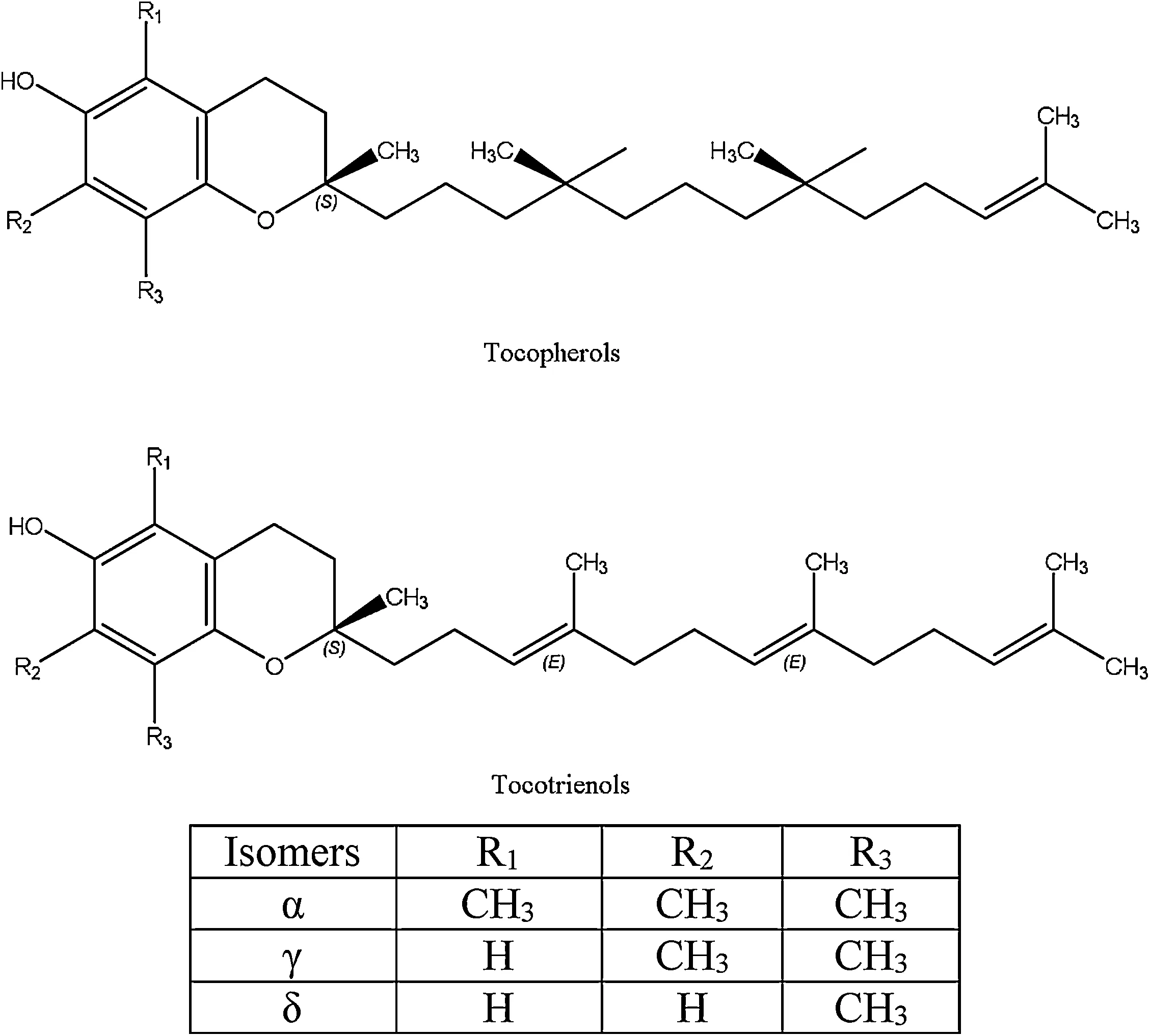
Fig.5.Structures of tocopherols and tocotrienols found in corn.

Fig.6.Structures of common plant sterols found in corn.
4.2.Type II diabetics
It is estimated by World Health Organization that people who live with diabetes increased from 108 million in 1980 to 422 million in 2014,and 1.5 million deaths was related to diabetes in 2014[92].Most the people who have diabetes have type 2 diabetes and they are unable to use insulin produced by their body properly.

Table4 Carotenoid content of white,yellow,red,blue,and high-carotenoid corn[32,33].
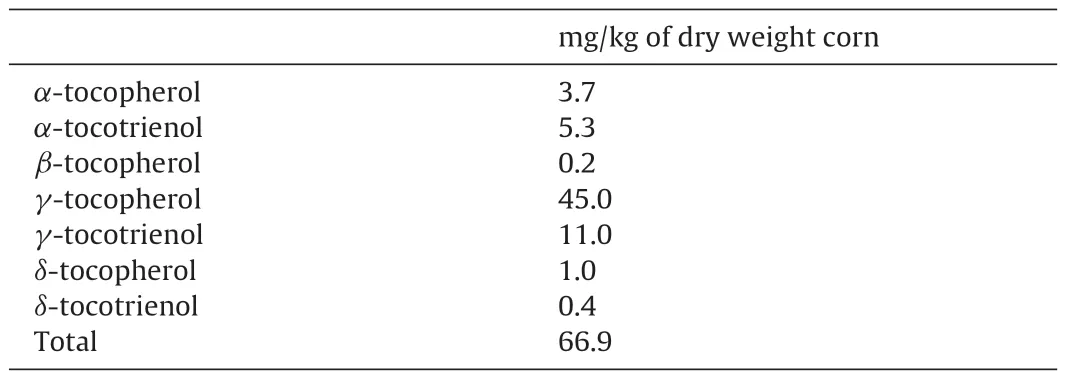
Table5 Vitamin E content in yellow corn[67].
A number of recent reviews [10,11,93,94]and epidemiology studies[9,12]have suggested that the consumption of whole grains and whole grain derived products are associated with reduced risk of type 2 diabetes.Dietary magnesium,fiber and vitamin E,which engage in the insulin metabolism,are found in whole grains.Regular consumption of these substances from whole grains may help regulate the insulin levels.Also,whole grains may help regulate insulin levels by the beneficial effects of releasing satiety feeling and lowering body weight index(BWI)[16].
High amylose content is positively associated with the high type 2 resistant starch content.Human studies with arepas,made of cornstarch,suggested that high amylose corn consumption is associated with a lower metabolic response[95].In this study,blood and serum insulin responses of people who consumed ordinary corn arepas were significantly higher than those who consumed high amylose corn arepas,suggesting that the high amylose content in corn is responsible for the slower metabolic response.[95].
Behall et al.reported that after 5 weeks of consumption of high amylose starch diet compared to the amylopectin starch diet,glucose and insulin responses were significantly lower [96].In a long-term study,Behall et al.investigated 24 men,10 of them were healthy and acted as the control group and 14 of them were hyperinsulinemic (HI) and acted as the treatment group.HI is not type 2 diabetes but often seen in the early stage of the disease.Subjects consumed products made with either high amylopectin(70%amylopectin,30% amlyose) or high-amylose starch (70% amylose,30%amylopectin).After 14 weeks,glucose response in both groups were similar,but the insulin response curves of the high amylose consumption group were much lower than the high amylopectin group.Fasting triglyceride concentration was also much lower in the high amylose consumption group than of the high amylopectin consumption group.The results suggest that long term consumption of high amylose corn starch may have beneficial effects on people with HI and diabetes by normalizing insulin response[97].A latter research study conducted by Behall et al.on 25 healthy subjects,13 men and 12 women with different concentration of amylose (30%–70%),found similar results to the study above that consumption of a meal in high amylose corn starch lower peak compare to that in low amylose corn starch.This study also found that intake of high amylose corn starch also lowered peak glucose levels.In addition,the results suggested that amylose content needed to be greater than 50%to have a significant effect on lowering glucose and insulin levels[98].
Resistant starch from corn has exhibited beneficial effects on lowering type 2 diabetes.Yamada et al.reported that daily consumption of 6 to 12 g of RS2,which is retrograded amylose,has beneficial effects on postprandial glucose and insulin levels(Yamada et al.,2005).High amylose starch is a type of RS with amylose content usually ranging from 30 to 70%of the total weight.A study conducted by Maki et al.on beneficial effects of resistant starch from high amylose corn on overweight and obese adults(11 men and 22 women,33 total) suggested that RS2 from corn increased insulin sensitivity only on men and women are less sensitive to change of circulating free fatty acids[99].
4.3.Obesity
In 2016,the estimated worldwide overweight and obesity population were 1.9 billion and 650 million,respectively [100].The number of obesity nearly tripled since 1975.Results from shortterm[14]and long-term[13]epidemiology studies support that the intake of whole grains and whole grain derived foods are inversely associated with the increased risk of obesity.
In a prospective cohort study,Liu et al.conducted research on the association between whole grains and dietary fiber intake and development of obesity on 74,091 US female nurses.Over the 12-year period,women who consumed more dietary fiber weighed 1.52 kg less than those who had only a slight increase intake of dietary fiber.Women who consistently consumed more whole grains weighted less than those who consumed less whole grains.The research also indicated that obesity was positively related to the intake of refined grains[13].Higgins et al.conducted research on replacing total carbohydrates with 0%–10.7% RS (retrograded amylose),which is abundant in high amylose corn starch.The results indicated that replacement of 5.4%or more of total dietary carbohydrates with corn RS significantly increased post-prandial lipid oxidation,suggesting the consumption of corn RS decreases fat accumulation[24].
Corn bran may have a benefit on lowering weight gain and obesity by providing satiety feelings.A study of satiety response of high fiber muffins(8.0–9.6 g fiber)versus low fiber food(1.6 g fiber)conducted by Willis et al.on 20 healthy men and women suggesting that muffin with resistant starch and corn bran had the most impact on satiety[101].Oat and barley bran seems do not exhibit the similar effect as corn bran of providing better satiety response than the control low fiber diet[102].
4.4.Digestive health
A daily consumption of 20 g resistant starch had a beneficial effect on promoting digestive heath [103].Corn and corn derived products are rich in resistant starch,a form of insoluble dietary fiber.According to the USDA national nutrient data base,7.3 g of dietary fiber presented in every 100 g of white and yellow corn grains [104].Less than three percent of the US population meets the adequate intake recommendation of 14 g dietary fiber per 1000 kcal,or 25 g per day for adult women and 38 g per day for adult men [105].RSs have potential health benefits of enhancing laxation and fermentation,increasing uptake of minerals,serving as prebiotics and reducing the symptoms of diarrhea.Most RSs survive through the digestive tract thus bring more bioactive compounds to the colon[81,106].
Compared with a starch free diet,a diet containing 17–30 g/day corn RS increased stool wet weight by 2.7 g/day.RS in corn increased fecal short-chain fatty acids excretion and the proportion of acetate in feces significantly.RS increased laxative health through stimulation of biomass and sparing of non-starch polysaccharides(NSP)breakdown[25].
Muir et al.conducted research that pertained to the effect of the combination of whole wheat bran with resistant starch in corn on fecal indexes [23].The randomized block-design study on 20 volunteers included three diets,control,wheat bran (WB) only (12 g fiber/d)and combination of WB and corn resistant starch(RS)(12 g WB fiber/d and 22 g RS/d).Compared with the control group,the WB only group resulted in a 22.90% increase of wet fecal output,5.96% increase of butyrate concentration in daily excretion,6.38%decrease of propionate concentration and 4.17% decrease of total SCFAs in excretion.The WB and RS combined diet resulted in a 56%increase of wet fecal output,79.47% increase of butyrate concentration,17.02%decrease of propionate concentration and a 21.88%increase of total SCFAs in excretion.The WB only diet did not show such a strong improvement of fecal indexes suggesting a synergic effect of the combination of whole grains and corn dietary fiber on digestive health[23].
An animalstudyfoundthatconsumptionof resistant starch from corn (161.15 g RS from corn starch/kg diets) significantly shortened intestinal transit time in streptozotocin-induced diabetic rats compared to consumption of resistant starch from rice (161.15 g RS mainly from rice starch/kg diets).Briefly,rats were separated into four groups,non-diabetic healthy mouse with no-intervention diet as control,diabetic with no intervention,diabetic with corn resistant starch intervention,diabetic with resistant starch from rice intervention.All groups consumed the same amount of food intake.RS from corn,RS from rice and diabetes groups showed positive results that the body and organ body weight were significantly reduced compared to the control group and diabetes groups.The transit time at 2 weeks of feeding with RS corn was 15%shorter than RS rice and 31.11%shorter than the control group.When compared with the diabetes group,the transit time with RS corn was 26.41%shorter and with RS rice was 13.21%shorter[107].
5.Conclusion
Although the consumption of corn can be traced back to the fifteenth centuries,corn has drawn increasing attention globally due to it being rich in nutrients,bioactive compounds,and phytochemicals along with potential health promoting benefits found in the most recent decades.Most phytochemicals in corn are present in bran and germ fractions instead of the endosperm fraction.Human clinical trials,epidemiological studies,and some animal studies have implicated that regular consumption of corn and its derived whole grain products is associated with reduced risk of developing chronic diseases such as cardiovascular disease,type 2 diabetes,and obesity.The high amylose content in corn contributes to the digestive health by its nature of resistance to digestion thus bringing bioactive compounds to the colon.Therefore,dietary modifications of increasing corn and other whole grain consumption is a practical strategy to optimize health and reduce the risk of chronic diseases.
Corn is rich in phytochemicals including phenolic acids,flavonoids,carotenoids,fiber,and resistant starch that are complementary to those in fruits,vegetables and other whole grains when consumed together [36].The benefits of resistant starch in corn have been well studied,and a moderate intake of RS (about 10 g/day) from corn starch has benefits on reducing glucose and insulin response,and a higher intake of RS (20 g/day) from corn starch promotes the digestive health.There is a lack of research on many other corn phytochemicals such as phenolic acids and flavonoids.Further research on the health benefits of phytochemicals in corn and sweet corn are warranted.
Acknowledgement
The authors declare no conflict of interest.
- 食品科學(xué)與人類健康(英文)的其它文章
- Behavioral assessment of hippocampal function following dietary intervention
- Study of interaction between metal ions and quercetin
- Prophylactic effect of Kudingcha polyphenols on oxazolone induced colitis through its antioxidant capacities
- Nutraceutical support for respiratory diseases
- Role of calpain system in meat tenderness:A review
- GUIDE FOR AUTHORS

